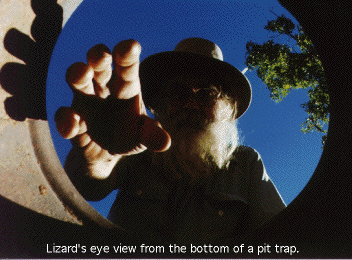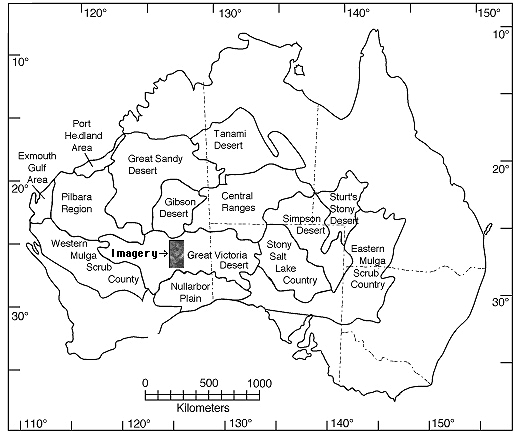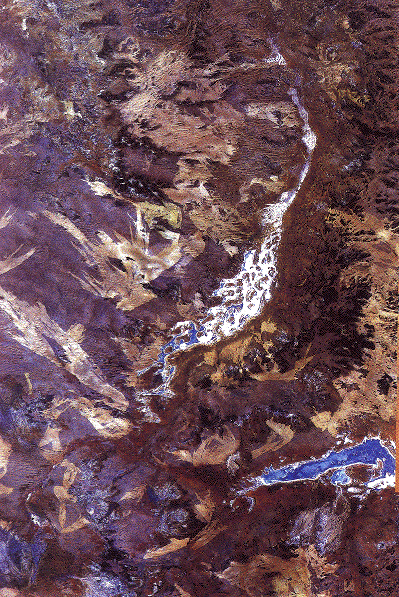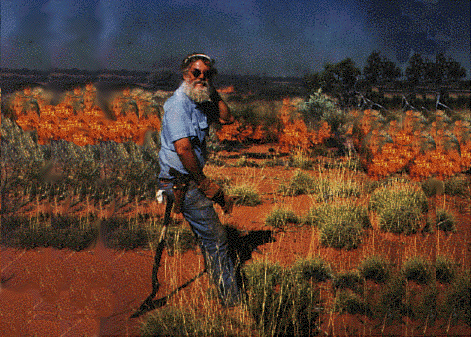|
Much of the digital satellite data has been acquired by Landsat, archived on magnetic tape. A complete analysis of wild fires for the Great Victoria desert region requires about one hundred images. Imagery has been purchased and analyzed to detect burned areas. Spectral and spatial statistics have been computed for nearly a thousand fires, and the probability that a given area will burn has been estimated. Other data collated for each fire include: date, location, area, perimeter, compass direction (of burn and prevailing wind), ground cover characteristics, extent of reticulation, as well as various fractal dimensions. (To read more about the remote sensing study, click here) Age and size distributions of burn patches have been estimated. Eventually, I hope to acquire supporting imagery from other grassland areas, particularly the Kalahari semidesert of southern Africa, to use for comparative purposes (fires in the Kalahari do not appear to reticulate to as great an extent as they do in Western Australia). |
|
A major goal of this study is to obtain baseline data on temporal patterns, spatial structure, and distribution of disturbances. These data will form the backdrop for a more detailed study of the population dynamics and dispersal abilities of species. Animals with active habitat selection such as Australian desert lizards should reach ecological and evolutionarily stable equilibria between "source" and "sink" habitats, with dispersal from the former to the latter maintaining the species locally. Such data on the metapopulations of component species will eventually be fitted into the overall spatial-temporal mosaic in an effort to explain the persistence of this diverse desert fauna. Ultimately, I plan to model the entire Great Victoria desert region as a dynamic habitat mosaic so as to understand mechanisms of coexistence of its component species and the effects of fire disturbance in maintaining diversity in this region. Faunas of unstudied sites will be predicted by extrapolation, thus allowing models to be to subjected to direct test. It should also be feasible to exploit controlled burns to test some aspects of such fire succession models. 
References Haydon, D. T. and E. R. Pianka. 1999. Metapopulation theory, landscape models, and species diversity. EcoScience 6: 316-328. Download pdf. Haydon, D. T., J. K. Friar, and E. R. Pianka. 2000. Fire Driven Dynamic Habitat Mosaics in the Great Victoria Desert I: Fire Geometry. Landscape Ecology 15: 373-381. Abstract, Download pdf. Haydon, D. T., J. K. Friar, and E. R. Pianka. 2000. Fire Driven Dynamic Habitat Mosaics in the Great Victoria Desert II: A spatial and temporal landscape model. Landscape Ecology 15: 407-423. Abstract. Download pdf. Pianka, E. R. 1992. Fire Ecology. Disturbance, spatial heterogeneity, and biotic diversity: fire succession in arid Australia. Research and Exploration 8: 352-371. Download pdf. Pianka, E. R. 1994. Biodiversity of Australian desert lizards. In C. I. Peng and C. H. Chou (eds.) Biodiversity and Terrestrial Ecosystems. Institute of Botany, Academica Sinica, Monograph Series No. 14, pp. 259-281. Download pdf. Pianka, E. R. 1996. Long-term changes in Lizard Assemblages in the Great Victoria Desert: Dynamic Habitat Mosaics in Response to Wildfires. Chapter 8 (pp. 191-215) in M. L. Cody and J. A. Smallwood (eds.) Long-term studies of vertebrate communities. Academic Press. Download pdf. Pianka, E. R. and S. E. Goodyear. 2012. Lizard responses to wildfire in arid interior Australia: Long-term experimental data and commonalities with other studies. Austral Ecology 37: 1-11. Download pdf. Return to Pianka lab page |



